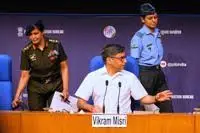Operation Sindoor: Meet Col Sofiya Qureshi and Wing Commander Vyomika Singh leading Modi Govt’s military messaging

India’s recent military operation, Operation Sindoor, marks a bold shift in both strategic military action and public communication, especially with women leading the messaging. The operation, which came in response to a terrorist attack in Pahalgam, Jammu and Kashmir, on April 22, 2025, that claimed the lives of 26 civilians, was a significant moment for both national security and for women in defense. Col. Sofiya Qureshi of the Indian Army and Wing Commander Vyomika Singh of the Indian Air Force stood at the forefront, spearheading the operation’s media briefings, signaling both military precision and evolving gender roles in India’s armed forces.
The Operation: A Strategic Response
Operation Sindoor aimed to dismantle the terror infrastructure operating in Pakistan and Pakistan-Occupied Kashmir (PoK). On May 7, 2025, India launched precision missile strikes against nine terrorist camps believed to be affiliated with groups such as Jaish-e-Mohammed, Lashkar-e-Taiba, and Hizbul Mujahideen. These camps, chosen based on credible intelligence, were key targets in India’s ongoing campaign to counter cross-border terrorism.
The operation’s name, Sindoor, is a poignant tribute to the women who lost their husbands in the Pahalgam attack. The term, often associated with married women in India, resonates as a symbol of sacrifice and resilience in the face of terrorism.
Col. Sofiya Qureshi: A Trailblazer in Army Leadership
Col. Sofiya Qureshi’s leadership role in Operation Sindoor is not her first in breaking barriers. In 2016, she became the first female officer to lead an Indian Army contingent in a multinational military exercise. Her vast experience in peacekeeping missions, combined with her meticulous approach to operations, made her an ideal leader for this high-profile mission.
In her briefing on May 7, Col. Qureshi emphasized that the strikes were carried out with utmost precision, targeting only the terrorist camps and ensuring that no civilian or military infrastructure in Pakistan was harmed. She described the operation as part of a larger strategy to decimate the terror ecosystem, dismantling it piece by piece.
Wing Commander Vyomika Singh: Pioneering Air Force Leadership
A pilot with over 2,500 flying hours, Wing Commander Vyomika Singh’s career trajectory is a testament to the growing prominence of women in combat roles within the Indian Air Force. Joining the Air Force in 2019, Singh quickly rose to prominence for her leadership in rescue operations, especially in challenging terrains like Jammu and Kashmir and the Northeast.
In the wake of Operation Sindoor, Wing Commander Singh played a pivotal role in explaining the operation’s objectives. She highlighted that the Indian Air Force’s involvement was crucial in ensuring the accuracy of the missile strikes, making it clear that India’s military response to any further provocation would be swift, decisive, and unwavering. Her firm stance on zero tolerance for terrorism resonated deeply during the media briefing.
A Symbol of Gender Equality in Military Leadership
One of the defining aspects of Operation Sindoor was the visibility of female leadership in the Indian military. Both Col. Qureshi and Wing Commander Singh, leading the operation’s media narrative alongside Foreign Secretary Vikram Misri, not only reassured the nation about the operation’s success but also symbolized India’s growing inclusivity in its defense forces.
These women, by taking charge of the military messaging, signaled a new era for the Indian Armed Forces, where women are not just serving in roles of combat and strategy, but are also shaping public perception and policy. Their participation in such high-level military communications also underscores the increasing role of women in national security—roles once dominated by men.
Strategic Messaging and the Modi Government’s Narrative
The Modi government’s careful decision to place two women officers at the helm of Operation Sindoor’s public face was intentional. Beyond the military victory, the operation became a narrative of resilience, strength, and justice. By choosing two capable women to lead the press briefings, the government sent a message not only about India’s military might but also about its progressive stance on gender equality.
In addition to their leadership in the operation, the two women officers emphasized that India would continue to hold Pakistan accountable for harboring terrorists and that India’s defense strategy would remain uncompromising. This messaging is vital in an era where national security is a top priority for both the government and citizens alike.
Conclusion
Operation Sindoor is more than just a military operation—it is a message of resilience, justice, and the evolving role of women in India’s defense forces. Col. Sofiya Qureshi and Wing Commander Vyomika Singh, by leading the charge in both military action and public messaging, have become powerful symbols of the strength and determination of the Indian Armed Forces. Their roles in the operation mark a pivotal moment in Indian military history, reflecting the country’s readiness to face challenges head-on and its commitment to empowering women in all spheres of society.






